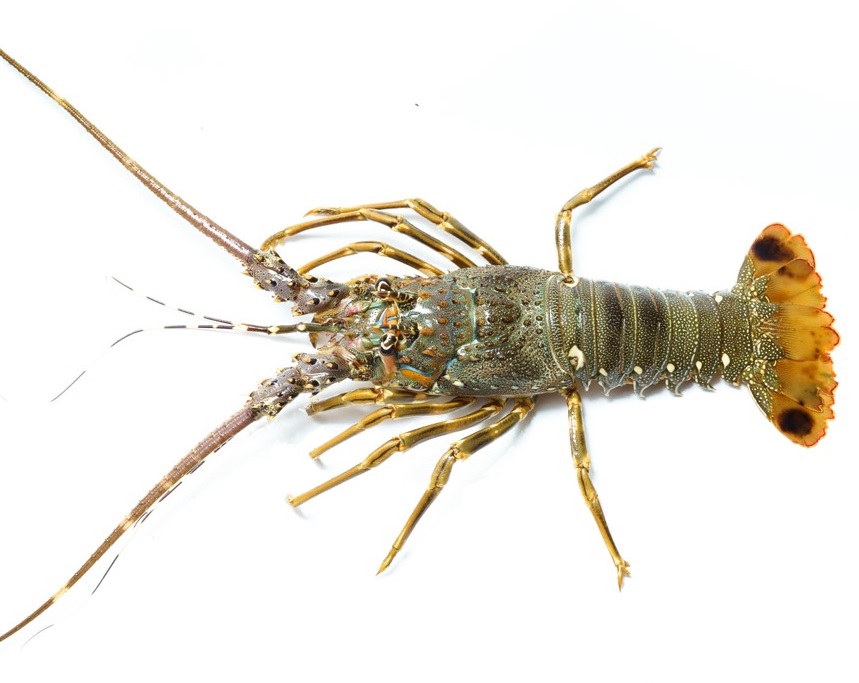
SPECIES
Panulirus ornatus
The Ornate spiny lobster, Panulirus ornatus is also known as the Tropical rock lobster. These lobsters are among the largest of the Panulirus lobster family and are greatly favored as a delicacy. Being brightly colored they are probably the best-looking spiny lobsters which makes them very well received in the live market trade throughout South East Asia.
These lobsters can grow to a maximum length of 50 cm but most are smaller around 30 to 40 cm range. The body is covered in a hard carapace with numerous forward pointing orange spins with two prominent forward-facing spines between the eyes. The tail is covered in a segmented carapace allowing it to flex and provide powerful rearward propulsion. They have two sets of feelers, one large pair covered in spines which can fold backwards and can be used for protection. When cornered they extend these feelers toward the threat.
They are found in the sub-tropical and tropical areas of the indo west Pacific area from the South African coast up the east coast of Africa including Madagascar across to Malaysia, Japan, and the northern coast of Australia. These lobsters are found on rocky and coral reefs usually shallower than 18 meters but have been found below 28 meters.
Panulirus ornatus are nocturnal feeders and eat a variety of mollusks, shrimp, crabs, worms, and sea urchins. They use their powerful legs to pull apart mollusks. Their main predators in the wild are the trigger fish, groupers, and octopuses.
This specie of lobsters has separate sexes and at maturity which is generally around four to five years they begin breeding. Males deposit a sperm packet on the underside of the females and after they ripen, they release up to 100,000 eggs which are carried under the female’s tail. Females have specialized attachments on the underside of the tail for the eggs to hook onto. The eggs start off bright red-orange color and as they develop, they go a dark muddy brown color.



Once the eggs hatch, they become planktonic, free floating in the ocean water column for ten to eleven months before settling as a Puerulus. Very few of these larvae survive until the adult stage or as a Puerulus. This is one of the main principals of GSA’s mission statement to take these lobsters at the Puerulus stage and place in a Nursery to develop to around 5 grams before transferring to a large grow out farm. Once in the Nursery environment GSA can have up to 98% survivability before transferring to the grow out farm.
SPECIES
Panulirus homarus
The Panulirus homarus is also known as the Tropical Spiny lobster or the Green Spiny Lobster. These lobsters are common size in the Panulirus lobster family and are greatly favored as a delicacy. The Green Spiny Lobster is very well received in the live market trade throughout South East Asia and is in high demand.
These lobster can grow to a maximum length of 31 cm but most are smaller around 20 to 25 cm range. The body is covered in a hard carapace with numerous forward pointing green spins with two prominent forward-facing spines between the eyes. The tail is covered in a segmented carapace allowing it to flex and provide powerful rearward propulsion. They have two sets of feelers, one large pair covered in spines which can fold backwards and can be used for protection. When cornered they extend these feelers toward the threat.
They are found in the sub-tropical and tropical areas of the indo west Pacific area from the South African coast up the east coast of Africa including Madagascar across to Malaysia, Japan, and the northern coast of Australia. These lobsters are found on rocky and coral reefs usually shallower than 5 meters but have been found below 90 meters.
Panulirus homarus are nocturnal feeders and eat a variety of mollusks, shrimp, crabs, worms, and sea urchins. They use their powerful legs to pull apart mollusks. Their main predators in the wild are the trigger fish, groupers, and octopuses.
This specie of lobsters has separate sexes and at maturity which is generally around four to five years they begin breeding. Males deposit a sperm packet on the underside of the females and after they ripen, they release up to 50,000 eggs which are carried under the female’s tail. Females have specialized attachments on the underside of the tail for the eggs to hook onto. The eggs start off bright red-orange color and as they develop, they go a dark muddy brown color.



Once the eggs hatch, they become planktonic, free floating in the ocean water column for ten to eleven months before settling as a Puerulus. Very few of these larvae survive until the adult stage or as a Puerulus. This is one of the main principals of GSA’s mission statement to take these lobsters at the Puerulus stage and place them in the controlled grow out farm where their survivability is greatly increased. It is not uncommon for a lobster farm to realize up to 85% survival rates for this lobster from the Puerulus stage to a market sized lobster.